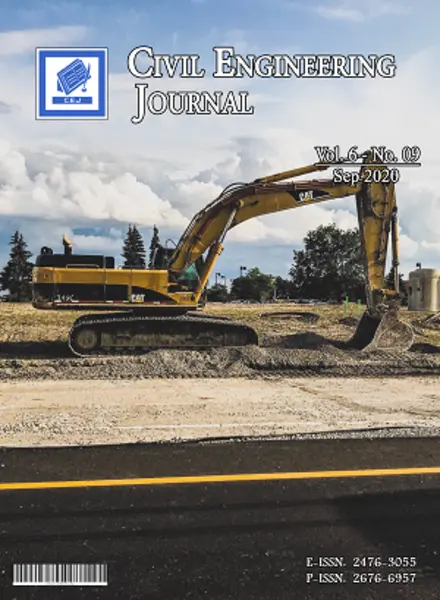-
fem optimisation of seepage control system used for base stability of excavation
جزئیات بیشتر مقاله- تاریخ ارائه: 1401/11/27
- تاریخ انتشار در تی پی بین: 1401/11/27
- تعداد بازدید: 121
- تعداد پرسش و پاسخ ها: 0
- شماره تماس ژورنال: 982188779475ext.258
fem optimisation of seepage control system used for base stability of excavation
with the existence of a high groundwater level, the head difference between the inside and outside of an excavation may lead to the loss of stability of the excavation’s surface. hence, a fundamental understanding of this occurrence is important for the design and construction of water-retaining structures. in some cases, the failure mechanism cannot be predicted exactly because of its mechanical complexity as well as a major lack of protection systems and not adopting effective countermeasures against this phenomenon.
the article took a tranche from an 80 km long open sewer located in the ruhr area, germany as an example to establish a hydro-geological model and analyse the instability of the excavation base surface caused by the groundwater flow at 45m deep and to present the effectivity of an adopted drainage system inside the excavation pit as 39 columns of sand to relax the pore water pressure.
by using the finite element method (fem) analysis, the failure mechanism was investigated before applying any countermeasures, and the total length of the adopted countermeasure system was minimised. also, various position tests were performed on the adopted drainage system to confirm the optimised position. the results of this numerical study allowed the deduction of the importance of the used drainage system by achieving 44% more in the excavating process. after achieving the required excavation depth, a further increase of the sand columns’ penetration may be considered non-economic because, after adding extra depth, all the situations have the same safety factor. in addition, this can provide a reference for the optimised position of the sand columns where they must be applied right by the wall and limited by a critical distance, d/2, half of the embedded depth of the wall.
حوزه های تحت پوشش ژورنال
مقالات جدیدترین رویدادها
-
استفاده از تحلیل اهمیت-عملکرد در ارائه الگوی مدیریت خلاقیت سازمانی و ارائه راهکار جهت بهبود
-
بررسی تاثیر ارزش وجوه نقد مازاد بر ساختار سرمایه شرکت های پذیرفته شده در بورس اوراق بهادار تهران
-
بررسی تأثیر سطح افشای ریسک بر قرارداد بدهی شرکت های پذیرفته شده در بورس اوراق بهادار تهران
-
بررسی تأثیر رتبه بندی اعتباری مبتنی بر مدل امتیاز بازار نوظهور بر نقد شوندگی سهام با تأکید بر خصوصی سازی شرکت ها
-
تأثیر آمیخته بازاریابی پوشاک ایرانی بر تصویر ذهنی مشتری پوشاک ایرانی (هاکوپیان)
-
بررسی تغییرات الکتروکوکلئوگرافی و پاسخهای شنیداری ساقه مغز در 100 بیمار مبتلا به منیر در بیمارستان رسول اکرم (ص) 1379-1377
-
تأثیر هوش هیجانی، ویژگی های شخصیتی و روابط بر تمایل به تغییر رفتار مصرف کننده در صنعت ورزش
-
واکاوی وضعیت آموزش مهارت های اساسی زندگی در پایه ششم ابتدایی از دیدگاه معلمان و متخصصان
-
بازشناسی راهکارهای طراحی مطابق با الگوهای پایداری محیطی در معماری بافت قدیم بوشهر
-
بررسی آزمایشگاهی رفتار شمع پافیلی تحت بارهای کششی مایل در خاک ماسه ای
مقالات جدیدترین ژورنال ها
-
مدیریت و بررسی افسردگی دانش آموزان دختر مقطع متوسطه دوم در دروان کرونا در شهرستان دزفول
-
مدیریت و بررسی خرد سیاسی در اندیشه ی فردوسی در ادب ایران
-
واکاوی و مدیریت توصیفی قلمدان(جاکلیدی)ضریح در موزه آستان قدس رضوی
-
بررسی تاثیر خلاقیت، دانش و انگیزه کارکنان بر پیشنهادات نوآورانه کارکنان ( مورد مطالعه: هتل های 3 و 4 ستاره استان کرمان)
-
بررسی تاثیر کیفیت سیستم های اطلاعاتی بر تصمیم گیری موفق در شرکتهای تولیدی استان اصفهان (مورد مطالعه: مدیران شرکتهای تولیدی استان اصفهان)
-
پیش بینی انسجام و کارکردهای خانوادگی در زوج ها، براساس عمل به باورهای دین
-
جرم شناسی اطفال و ارزیابی شخصیت اطفال بزهکار
-
تجلی مضامین دینی در نقوش انسانی ظروف سفالین دوره سلجوقی
-
determination of organochlorine and organophosphorous pesticide residues in irrigated water from gubi, waya dams and gudum fulani irrigation sites in bauchi lga, bauchi state,nigeria using composite sampling
-
investigation into the effect of bed stiffness on seismic performance of concrete gravity dam under far- and near- field earthquakes


سوال خود را در مورد این مقاله مطرح نمایید :